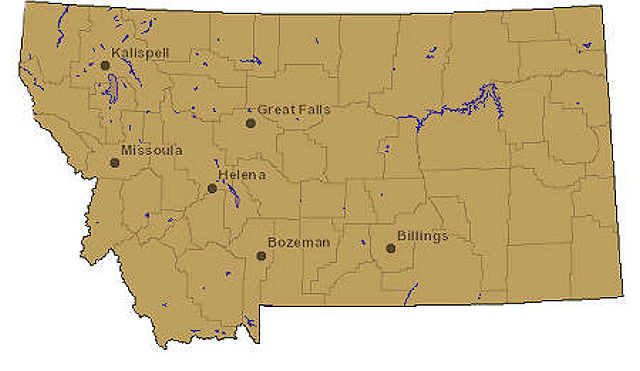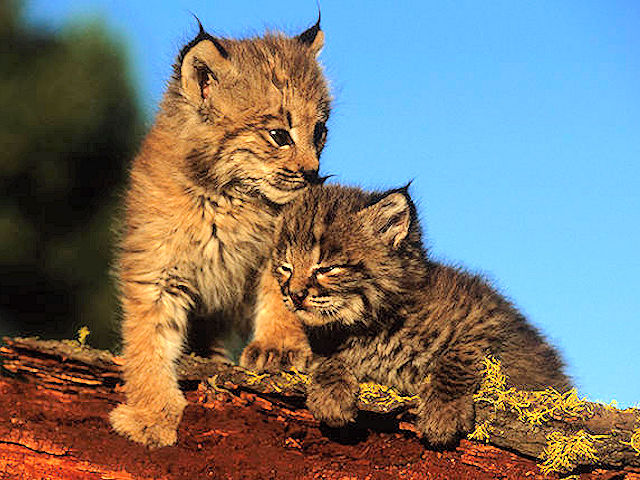Bobcat

Felis rufus
Order: Carnivora
Family: Felidae
Other Names: Bay lynx, barred bobcat, catamount, cat of the mountains, lynx cat, pallid bobcat, red lynx, wildcat.
Status: Very valuable fur animal. Official Montana furbearer managed and protected by regulated fur harvest seasons.
Identifying Characteristics: The bobcat is about twice the size of a domestic cat and is the smallest of our native cats. Individuals exhibit considerable variation in color. Base coloration can be light gray, yellowish-brown, buff, brown, or reddish-brown. Underparts and inside of legs are white with black or dark brown spots.
Facial fur is often streaked with black. Dorsal surfaces of the ears are black with a prominent white spot. Short tuft of black hair is present on the ears. This cat has a short tail, black only on the upper portion of the tip. Bobcat fur is short, dense, and soft. Retractile claws.
Total length: 28 to 37 inches. Weight: 15 to 35 pounds.
Habitat: Utilizes wide variety of habitats; known to be an animal of patchy country. Prefers rimrock and grassland/shrubland areas. Often found in areas with dense understory vegetation and high prey densities. Natural rocky areas are preferred den sites.
Food Habits: Snowshoe hares and jackrabbits are the most common prey. Also feeds heavily on medium-sized rodents. Will eat carrion.
Life History: May be active during all hours but is primarily nocturnal. Solitary animal that is difficult to observe in the wild. Usually mates during spring. Litter size averages from two to four. Gestation 50 to 60 days. Young born May through June.
Similar Species: Lynx - bobcat feet are much smaller than those of the lynx. Feet lack large furry pads characteristic of lynx. Also have shorter legs than lynx. Lynx has black color all the way around the tail tip. Other cats have a long tail.
Bobcats are widely distributed throughout the United States and southern Canada in a variety of habitats, from dense forests, to mountains, prairies, farmlands, and even deserts. They are rarely seen in the wild because the species normally travels by walking, and their keen eyesight and hearing are always on the alert for possible danger. Very capable predators, bobcats hunt by stalking their prey.
 Description
Description
Male bobcats are slightly larger and heavier than females. Most adult males weigh 20 to 22 pounds, while females average 18 to 19 pounds. Individuals may be much larger at times, especially in the northern states where many mature males may weigh 30 pounds. The heaviest recorded bobcat was taken in Maine and weighed 76 pounds.
Bobcats have short tails of 5 to 6 inches in length. The underside of the tail is whitish, and there is a black spot near the end of the tail. Lynx can be confused with bobcats in northern areas, but the lynx tail is totally black, top and bottom, over the entire end of the tail.
The bobcat has a face ruff of longer fur, and slightly tufted ears. The back side of the ears are dark in color, with obvious white centers.
Overall coloration is reddish, greyish or brownish on the backs, with lighter colored chins, throats, and bellies. Black spots are found on the front legs and bellies of bobcats, and some younger cats may be spotted almost all over the entire body. Spotting is less pronounced on older bobcats, which also tend to be darker in color.
Bobcats have retractable claws which do not show up in tracks. The claws are extended as the bobcat climbs a tree, catches prey, or defends itself.
Bobcat have 28 teeth, including four canine teeth. Meat is sheared off in sizes that can be swallowed whole, without chewing.
 Male bobcats do not breed as a rule until they are
nearly two years old. Juvenile females are
capable of breeding in their first year of life.
Litter sizes are usually 1 to 4, with 3 being
the average litter.
Male bobcats do not breed as a rule until they are
nearly two years old. Juvenile females are
capable of breeding in their first year of life.
Litter sizes are usually 1 to 4, with 3 being
the average litter.
Breeding normally takes place during February or March. Gestation is 62 to 70 days. Some female bobcats will raise two litters in a single year, and late born young often stay with the mother throughout the winter. Breeding times can vary a great deal, and bobcats might be born in any month of the year.
Male bobcats are driven away after breeding, and the males seek other females. Females raise litters alone, which require that they leave the young unattended to hunt.
Underground dens in rocky places are usually selected as first choices for natal dens. If these are not available, the female bobcat can choose a hollow tree, or the underground den of another species as bobcats do not dig their own dens.
Bobcats are dependent upon rabbits in all areas. Bobcat population densities often follow the cyclic densities of these rodents. Most young bobcats are on their own by October, and significant mortalities occur when there are few rabbits for the young bobcats to prey upon.
Habits
Bobcats have keen senses of vision and hearing.
The sense of smell is also developed, but
bobcats are more dependent upon sight and sound
to aid their particular style of hunting.
Territory sizes vary according to population densities, prey species densities, and region of the country. Males have much larger territories than females in all regions. A male bobcat's territory will often overlap several females as well as another male or two. A typical female will have a territory size of about 6 square miles, whereas a male's territory might be as large as 60 square miles. Bobcats do not utilize all of their territories, but seem to have circuitous routes that are traveled regularly. This habit allows constant reproduction of prey species within the territory.
Many female bobcats will not travel further than one mile in a night. Both male and female bobcats stop traveling after enough food has been killed, and both sexes rest after feeding. For this reason, the times it takes a bobcat to complete its circuit varies a great deal. Most bobcats return to a particular point on their circuit every week to three weeks.
Bobcats do not fear the water as much as other cat species. Bobcats commonly wade and swim, and many bobcats do not hesitate to attack a beaver in shallow water.
Bobcats are skilled tree climbers, and they do not hesitate to bound up a tree to avoid persecution. When they are treed at night by dogs, they often do not stay long but jump at the first opportunity. When they are treed during the daylight hours, they are prone to staying in the tree for longer periods.
A good degree of curiosity indicates that bobcats are somewhat intelligent. However, a bobcat is also moody or indifferent at times, which may indicate that the species responds most actively when it is hungry.
Bobcats are capable of good speed for short distances, but they normally walk while traveling. When a prey species is noticed, the bobcat will usually stalk the prey slowly until it is within leaping distance. At other times, a bobcat may conceal itself behind a rock or on a limb as it waits for a victim to come within striking distance.
Bobcats rely on cottontails, jackrabbits, or snowshoe hares for 75 to 90 percent of their diets. Venison is the next largest food item, followed by mice, ground squirrels, tree squirrels, and occasionally skunk, beaver, muskrat and birds. Adult deer can be killed by bobcats. This is most apt to happen during winter months as other food items become more difficult to catch.
General
Significant mortalities of juvenile bobcats can
occur during the first winter season. The young
bobcats are not as skilled at hunting as the
adults, and many do not survive their first
winter when the weather is severe and rabbit
populations are at a low cycle. Juvenile bobcats
are also vulnerable to predation by mature male
bobcats, coyotes, eagles, and fishers. Mountain
lions and wolves occasionally kill adult
bobcats. Predation by either species is not
thought to be significant.
Bobcats are vulnerable to rabies, feline distemper, mange mites, tapeworms, roundworms, lice, and bubonic plague.
As significant predators of rabbits, bobcats help to stabilize rabbit population cycles which benefit many predatory species. More rabbits are killed when they are very abundant. During periods of low rabbit populations, many bobcats become malnourished and vulnerable to a variety of diseases and exposure to harsh weather conditions. These controls limit bobcat survival, and protect breeding populations of rabbits during these low cycles.
Adult bobcats do prey upon deer, especially when rabbits are spare and the deer are most vulnerable during winter conditions of deep snow. A bobcat usually eats no more than 2 or 3 pounds of meat per day, and the deer carcass often serves as a food source for other species as well. Some bobcats in western areas do prey upon sheep, and a single bobcat has been known to kill dozens of lambs in one night.
A bobcat is considered to be old at 10 years of age.